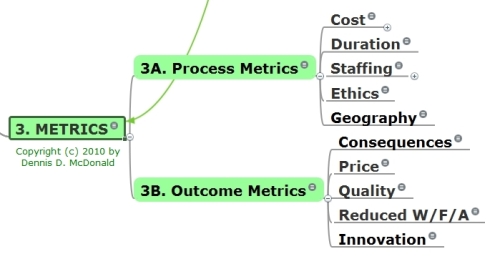Geography and Innovation: Additional Metrics for Assessing the Impact of Collaboration on Federal Acquisition
I’ve updated the model of “acquisition collaboration” I first presented in Justifying Collaboration in Complex Programs such as Federal Acquisitions based on some additional research and interviews. As discussed there I am developing an approach to assessing the impact on Federal procurement of using improved communication and collaboration technologies.
Here’s what the “metrics” portion of the model now looks like (not all branches are displayed; let me know if you would like to see more details):
Figure 1. “Metrics” Portion of “Acquisition Collaboration” Model

The two items added to the “3. Metrics” portion of the model are “Geography” (under “3.A Process Metrics”) and “Innovation” (under “3.B Outcome Metrics.”)
Geography
Hal Good pointed out to me that a possible outcome from making improved use of communication and collaboration technology is to reduce the “geographic bias” that some believe operates in Federal procurement where vendors far removed from East Coast or Midwest procurement centers feel disadvantaged by their distance from contract officers and potential business partners. For example, real-time audio and video conferencing systems are already used by some procurement agencies to provide better communication around events such as vendor conferences and question and answer sessions.
Hal adds, though, that one’s perspective on this may change depending on the type of procurement. If you’re managing a local government purchasing program, for example, you may be required to compete local vendors — assuming there are local vendors for what you’re procuring.
Innovation
I added “innovation” as a possible metric category for assessing the impact of improved collaboration on procurement based on what is coming out of targeted applications of “web 2.0” collaborative approaches being employed by Federal agencies. A prime example is the GSA’s BetterBuy Project. The question goes something like this: if we make it easier for the participants in the procurement process to communicate and collaborate through all the stages of the procurement, will we increase the likelihood that an innovative product or service might emerge from the procurement process?
Granted, “innovation” is potentially just as elusive to define as “quality,” which is another one of the outcome metrics in my model. But based on my own research, I’ve concluded that it is sometimes appropriate to treat innovation as a manageable goal. Incorporating innovation as a desirable feature of the procurement process should therefore make as much sense as other requirements, especially when the focus is less on how a product or service is defined than on whether the desired outcomes of the procurement are attained.
For more information
Do you have some ideas about these topics you’d like to share? Please feel free to use the comment feature below, or if you’re interested in a more detailed walk-through of the model, please contact me directly at ddmcd@yahoo.com.
Copyright (c) 2010 by Dennis D. McDonald